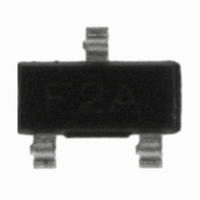HSMP-3822-TR1G Avago Technologies US Inc., HSMP-3822-TR1G Datasheet - Page 7

HSMP-3822-TR1G
Manufacturer Part Number
HSMP-3822-TR1G
Description
DIODE PIN SWITCH 50V SOT-23
Manufacturer
Avago Technologies US Inc.
Datasheet
1.HSMP-3820-BLKG.pdf
(10 pages)
Specifications of HSMP-3822-TR1G
Package / Case
SOT-23-3, TO-236-3, Micro3™, SSD3, SST3
Diode Type
PIN - 1 Pair Series Connection
Voltage - Peak Reverse (max)
50V
Current - Max
1A
Capacitance @ Vr, F
0.8pF @ 20V, 1MHz
Resistance @ If, F
600 mOhm @ 10mA, 100MHz
Configuration
Dual Series
Reverse Voltage
50 V
Forward Continuous Current
1 A
Frequency Range
UHF
Termination Style
SMD/SMT
Carrier Life
0.07 us
Maximum Diode Capacitance
0.8 pF @ 20 V
Maximum Operating Temperature
+ 150 C
Maximum Series Resistance @ Maximum If
0.6 Ohm @ 10 mA
Minimum Operating Temperature
- 65 C
Mounting Style
SMD/SMT
Recovery Time
7 nS
Diode Case Style
SOT-23
Breakdown Voltage
50V
Capacitance Ct
0.8pF
Leaded Process Compatible
Yes
Peak Reflow Compatible (260 C)
Yes
Reel Quantity
3000
Rohs Compliant
Yes
Lead Free Status / RoHS Status
Lead free / RoHS Compliant
Power Dissipation (max)
-
Lead Free Status / Rohs Status
Lead free / RoHS Compliant
Other names
516-1802-2
HSMP-3822-TR1G
HSMP-3822-TR1G
Available stocks
Company
Part Number
Manufacturer
Quantity
Price
Company:
Part Number:
HSMP-3822-TR1G
Manufacturer:
AVAGO
Quantity:
769
Company:
Part Number:
HSMP-3822-TR1G
Manufacturer:
AVAGO
Quantity:
223 697
SMT Assembly
Reliable assembly of surface mount components is a
complex process that involves many material, process,
and equipment factors, including: method of heating
(e.g., IR or vapor phase reflow, wave soldering, etc.) circuit
board material, conductor thickness and pattern, type of
solder alloy, and the thermal conductivity and thermal
mass of components. Components with a low mass, such
as the SOT-323/-23 package, will reach solder reflow
temperatures faster than those with a greater mass.
Avago’s diodes have been qualified to the time-
temperature profile shown in Figure 21. This profile is
representative of an IR reflow type of surface mount
assembly process.
After ramping up from room temperature, the circuit
board with components attached to it (held in place with
solder paste) passes through one or more preheat zones.
Figure 21. Surface Mount Assembly Profile.
Lead-Free Reflow Profile Recommendation (IPC/JEDEC J-STD-020C)
Note 1: All temperatures refer to topside of the package, measured on the package body surface
7
Reflow Parameter
Average ramp-up rate (Liquidus Temperature (T
Preheat
Ts(max) to TL Ramp-up Rate
Time maintained above:
Peak Temperature (T
Time within 5 °C of actual Peak temperature (t
Ramp-down Rate
Time 25 °C to Peak Temperature
Tp
T
25
L
Ts
Ts
min
max
P
)
t 25
Preheat
°
ts
C to Peak
Temperature Min (T
Temperature Max (T
Time (min to max) (t
Temperature (T
Time (t
P
)
Ramp-up
S(max)
L
)
Time
to Peak)
L
)
S(min)
S(max)
S
)
Ramp-down
tp
)
)
The preheat zones increase the temperature of the
board and components to prevent thermal shock and
begin evaporating solvents from the solder paste. The
reflow zone briefly elevates the temperature sufficiently
to produce a reflow of the solder.
The rates of change of temperature for the ramp-up and
cool-down zones are chosen to be low enough to not
cause d eformation o f t he b oard o r d amage t o c omponents
due to thermal shock. The maximum temperature in the
reflow zone (T
These parameters are typical for a surface mount
assembly process for Avago diodes. As a general
guideline, the circuit board and components should be
exposed only to the minimum temperatures and times
necessary to achieve a uniform reflow of solder.
t
L
Lead-Free Assembly
3°C/ second max
150°C
200°C
60-180 seconds
3°C/second max
217°C
60-150 seconds
260 +0/-5°C
20-40 seconds
6°C/second max
8 minutes max
MAX
Critical Zone
T
L
) should not exceed 260°C.
to Tp















